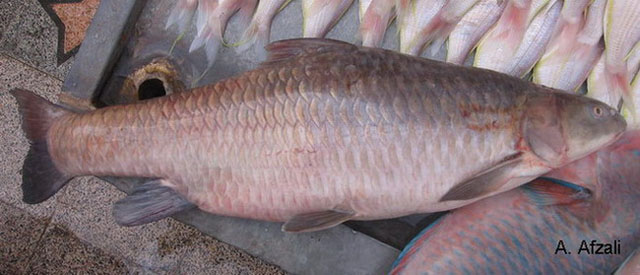| Cyprinidae (Minnows or carps), subfamily: Torinae |
| 150 cm TL (male/unsexed); max.weight: 30 kg; max. reported age: 17 years |
|
benthopelagic; freshwater, |
| Asia: Tigris-Euphrates basin in Iraq and Syria (Ref. 96964), rivers of southern Iran (Ref. 96964) and possibly Orontes River (Ref. 96964). |
|
Dorsal spines (total): 0-0; Dorsal soft rays (total): 10-13; Anal spines: 0-0; Anal soft rays: 7-10. Diagnosis: Arabibarbus grypus has 33-44 scales in the lateral line (Ref. 96964). The round head is shorter, 19.9-25.4% of standard length, and lower, 12.6-16.0% of standard length, than in its congeners (Ref. 96964). The body is cylindrical; the dorsal fin is short, 17.8-24.2% of standard length, and only weakly ossified; the pectoral fins, 16.0-19.3% of standard length, and pelvic fins, 14.3-17.5% of standard length, are shorter than in Arabibarbus hadhrami (Ref. 96964).
Description: The body is slender and laterally flattened in small juveniles; it is strong and cylindrical in larger specimens; a nuchal hump is absent; the head is short and round with a convex dorsal profile and a straight to slightly convex ventral profile; the head length is greater than the body depth (Ref. 96964). The mouth is sub-terminal with two pairs of barbels, which are about as long as the eye diameter; a median lobe is present on the lower lip; it is small in some specimens but well developed in others; the lips are inconspicuous in most specimens, but can be thick and fleshy in some; the eyes are lateral in the anterior half of the head and slightly protuberant (Ref. 96964).The dorsal fin is short and has 3-4 unbranched and 7-9 branched rays; the last unbranched ray is about as long as the head, weakly ossified and the distal part is flexible; the anal fin has 3-4 unbranched and 4-6 branched rays (Ref. 96964). It has 33-44 scales in the lateral line, 4.5-5.5 scales above the lateral line, 3.5-5.5 scales below the lateral line and 11-12 scales around the caudal peduncle; the scales are shield-shaped and have numerous parallel radii (Ref. 96964). The pharyngeal teeth count is 2.3.5-5.3.2; the pharyngeal teeth are hooked at the tip (Ref. 96964). There are 13-15 gill rakers on the lower limb and 3-5 gill rakers on the upper limb of the first gill arch (Ref. 96964).
Colouration: Live specimens are light grey to bronze and white ventrally; the back is darker than the flanks; the caudal fin is slightly orange in many specimens (Ref. 96964). Fixed specimens are yellow to brown, the dorsal area is darker than the flanks and the belly (Ref. 96964). |
| Found in small to large rivers (Ref. 96964). It can attain sizes of up to 2 m and a mass of 100 kg (Ref. 96964). |
|
Vulnerable (VU); Date assessed: 18 March 2013 (A2d+3d) Ref. (130435)
|
| harmless |
Source and more info: www.fishbase.org. For personal, classroom, and other internal use only. Not for publication.

